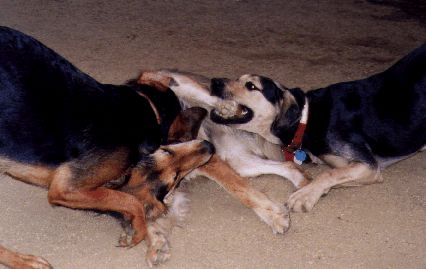Child's Play
Karla Schultz
Mechanism
Neurological Studies on Play (click here)
The Anatomy of Playtime
In dog-dog play interaction, a good deal of communication must take place in order for the play behavior not to be misconstrued as actual aggression.
Initiation of the play sequence is the metacommunicative signal that conveys to the receiver that the actions that follow it should not be taken as genuine. The "pre-communication" signal frequently used by dogs is the the "play bow," as seen below. Other signals used include the "play dance," play-rushes (the initiator runs quickly at the intended playmate then races away, looking back for acknowledgement), and pawing at the ground while making eye contact with the playmate. [2]
Continuation of the play sequence is a mixture of non-serious behaviors with interspersed initiation signals. What happens after the game starts is widely varied, usually incorporating several different sequences. During dyadic play, one role played is the "attacker," where the dog pursues the playmate by chasing, tackling, biting, and mounting them. The other is the "loser," who often voluntarily plays out the submissive role, or self-handicaps. Self-handicappng involves rolling on the back, allowing for the genetals to be sniffed, allowing a muzzle bite, and licking the attacker's muzzle. The two dogs playing will switch roles multiple times during a single play session, although usually in an imbalanced proportion. [1] According to Spinka et al's theory on the adaptive value of play, the voluntary self-handicapping creates the temporary loss of control that prepares the dog for future stressful events [7].
Play biting
 [f]
[f]
Play fighting (there are in fact 3 dogs here)
 [g]
[g]
Submissive roll
[e]
Neurological Studies on Play
(back to top)
Studies have been conducted to observe the neurological changes in rats during play stimulation. Play activities appear to have an effect on the somatosensory perception (sense perception), emotional experiences, and arousal control abilities of lab rats.Two potential locations for play-behavior related neurons were investigated during the study: the parafascicular nucleus of the thalamus (PNT) and the ventrobasal thalamic complex (VTC).
The PNT receives sensory information from the body in a diffuse, generalized manner. When the PNT was lesioned, a significant reduction of play pinning was noticed. When left intact, this area's neurons were excited during play. When the rat was given a full body tickle (thus stimulating its sensory system in a diffuse way), the rat emitted a large amount of squeaks commonly emitted during play.
The VTC receives sensory information in a much more focused, detailed way than the PNT. When this area was lesioned, no appreciable difference in play habits were noticed. During play, this area did not appear to be excited. When the rat received a "focused tickle" (a tickle to an individual body part rather than the entire body, thus activating the VTC more than the PNT), it emitted fewer play-squeak noises than when given the full body tickle. [7]